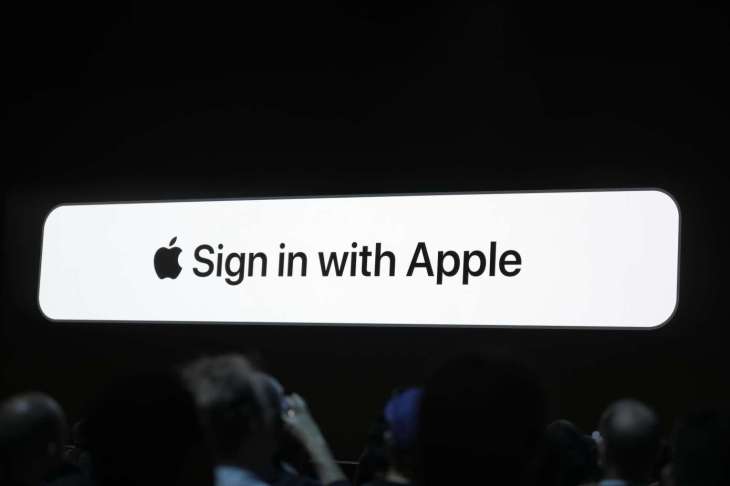
In this post, we'll debate about the benefits of providing Sign in with Apple in your app so you can decide if it worth integrating it or not. In the second part of this post we'll provide a step by step Sign in with Apple integration guide and talk about all the issues we run into and had to overcome.
In case you don't know What's Sign in with Apple yet...
Sign in with Apple is a new Apple service that makes it easy for users to sign in to your apps and websites using their Apple ID. Instead of filling out forms, verifying email addresses, and choosing new passwords, they can use Sign in with Apple to set up an account and start using your app right away.
Apple will make it mandatory by the end of June if you're already providing other third-party social media authentication such as Facebook, Google, Twitter, etc. You can visit App Store Review Guidelines for more info about Apple store review.
What does Sign in with Apple put on the table?
It provides a one tap frictionless login and authentication system to your app which means more people will login into your app and also a faster growth in the number of app users especially in Apple device owners who only need to check their identity through Touch Id or Face Id. By using Sign in with Apple, users don't need to remember app credentials, apps don't need to provide a password reset and identity and validation workflow in the app, neither provide a specific register and login form.
Sign in with Apple is FIDO U2F standard complaint, which means security aspects are met and we don't need to care about it. Apple adds two-factor authentication support by default, providing an extra layer of security.
Sometimes an app user would prefer Sign in with Apple over other alternatives because it has the ability to hide its real email, this still allows the app to reach the user real email through Apple servers. Apple provides a user's private email that is only reachable from the app registered email domains, so the user email doesn't have value outside app servers and can't be sold.
Even though Sign in with Apple is multiplatform which means we can make it work on the web, Android devices, Windows apps and platforms provided by Apple. The user still needs to have an Apple device to complete the two-factor authentication, upon Apple Id login the user receives a 2FA code from apple in their device. So if your app is available for not Apple devices owners just allowing Sign in with Apple is not an option.
At this point you should have gotten the point of all the benefits in adopting Sign in with Apple in your app and be able to decide if it's useful for your app. So now let's move on to a step by step integration guide.
Integration guide
Add Sign in with Apple capability
First of all, we need to add Sign in with Apple capability to our project. Open the Xcode project file. In the project editor, select the target and open the Signing & Capabilities tab. In the toolbar, click the + Capability button to open the Capabilities library and add the Sign in with Apple capability.

Add capability on Apple Developer Account
It's necessary to configure your project on Apple Developer Program portal. Go to Certificates, Identifiers & Profiles → Identifiers and search the identifier to the project. Search Sign in with Apple capability and if it's not enabled, enable it. Then, click Edit and choose Enable as primary App ID option as it's shown in the screenshot. Save the new configuration.

Go back to Certificates, Identifiers & Profile screen and go to the Keys page to register the new key. Press the + button and add the Sign in with Apple capability, then press the Configure button.
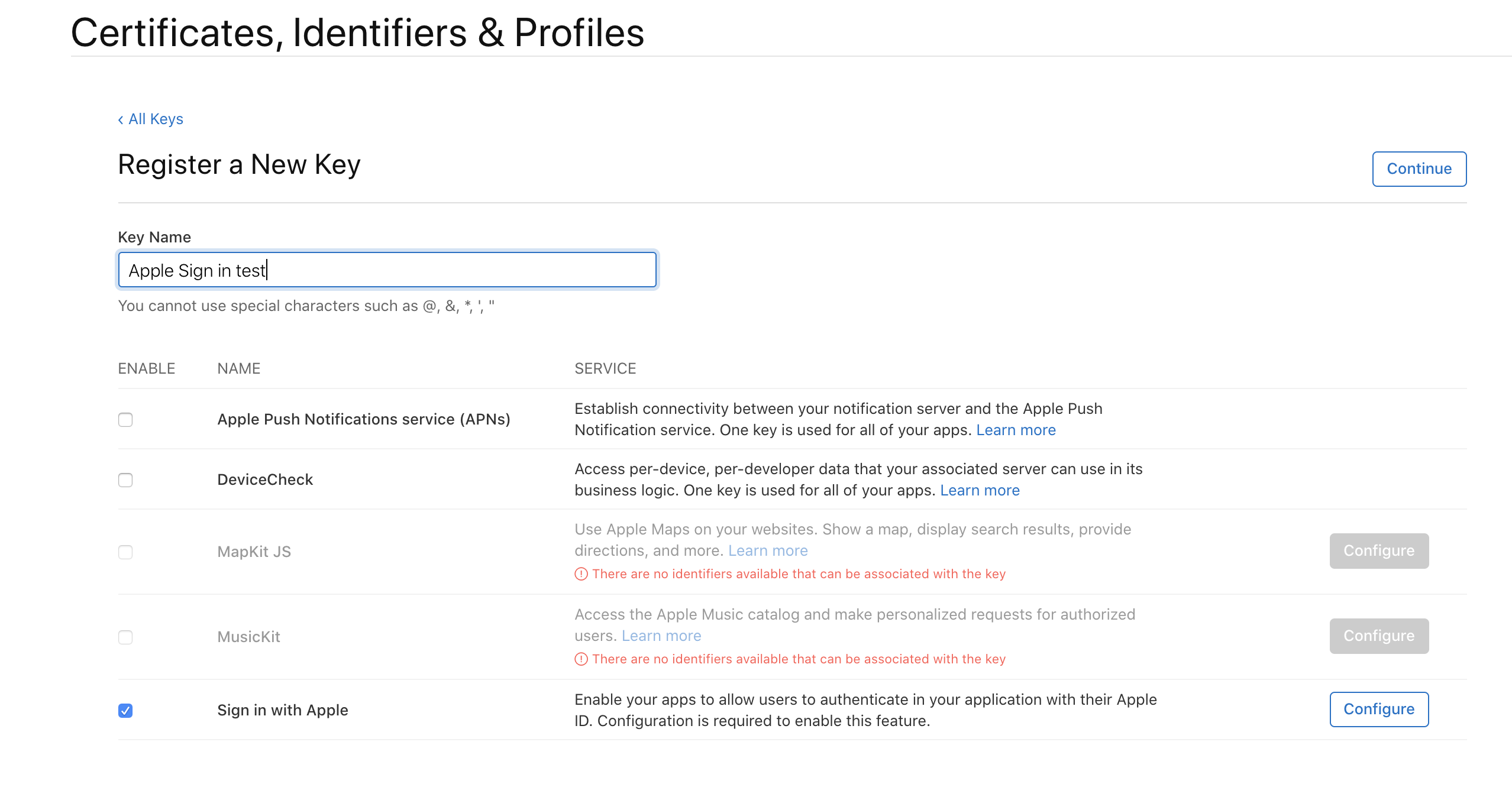
Make sure to select the correct Primary App ID and save the configuration key.
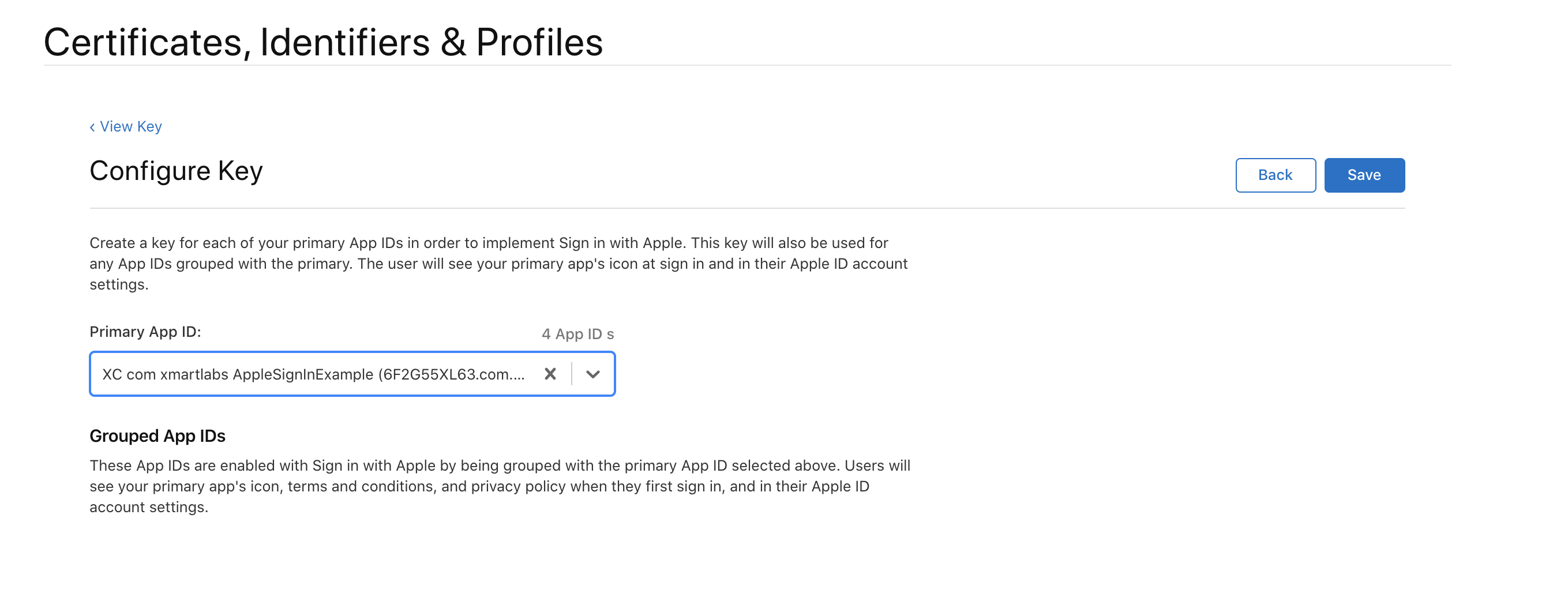
Now, we have the environment setup done, let's get into the code.
Add button
Although you can use your custom button, we strongly recommend using those provided by Apple which offers multiple benefits shown here.

It's necessary to import AuthenticationServices framework which provides ASAuthorizationAppleIDButton button class. Adding this button is very simple, you just need to create a button instance and set up its touchUpInside handler. Remember to add the button to the view hierarchy.
let button = ASAuthorizationAppleIDButton()
button.addTarget(self, action: #selector(handleAuthorizationAppleIDButtonPress), for: .touchUpInside)
self.loginProviderStackView.addArrangedSubview(button)
Handle button press
After we add the button, we need to implement the button tap handler. We'll request Sign in with Apple permissions using ASAuthorizationAppleIDProvider class and we'll use ASAuthorizationController to handle the authentication interface flow.
Let's implement the button handler
@objc func handleAuthorizationAppleIDButtonPress() {
let request = ASAuthorizationAppleIDProvider().createRequest() //1
request.requestedScopes = [.fullName, .email] //2
let authorizationController = ASAuthorizationController(authorizationRequests: [request]) //3
authorizationController.delegate = self
authorizationController.presentationContextProvider = self //4
authorizationController.performRequests() //5
}
- Create a request (
ASAuthorizationAppleIDRequest). To create it we need anASAuthorizationAppleIDProviderinstance. - Define the request scope, which is the data we want to receive from the user (in this case email and full name).
- Create a controller that manages authorization requests created by a provider.
- Provides a display context to present the authorization interface to the user.
- Perform the request and opens the authentication dialog shown below.

As we can see in the code snippet above, it's required to conform to ASAuthorizationControllerDelegate and ASAuthorizationControllerPresentationContextProviding protocols.
We conform to ASAuthorizationControllerPresentationContextProviding to indicate the window that will contain "Sign in with Apple" SDK dialogs, as shown in the code below.
// ASAuthorizationControllerPresentationContextProviding
func presentationAnchor(for controller: ASAuthorizationController) -> ASPresentationAnchor {
return self.view.window
}
Which user authentication data does we get from Apple?
We'll receive an ASAuthorizationAppleIDCredential instance, here are the principal information:
- User ID: The unique user ID
- Full name: User could edit his full name before sharing it with your app
- Email: A user's email address, which could either be the real user email or an obscured one
- Authorization Code & Identity Token: These are encrypted data your client app should send to the backend so it can validate the information's authenticity.
Full name and Email are optional and only available for new users, which means, users that are logging into the app for the first time.
How do we get this data?
We need to implement two functions of ASAuthorizationControllerDelegate protocol, one that handles a successful authentication and another to handle errors during authentication.
Let's start with success one:
func authorizationController(controller: ASAuthorizationController, didCompleteWithAuthorization authorization: ASAuthorization) {
if let appleIDCredential = authorization.credential as? ASAuthorizationAppleIDCredential {
let userId = appleIDCredential.user
let identityToken = appleIDCredential.identityToken
let authCode = appleIDCredential.authorizationCode
let email = appleIDCredential.email
let givenName = appleIDCredential.fullName?.givenName
let familyName = appleIDCredential.fullName?.familyName
// Here you have to send the data to the backend and according the response let the user get into the app.
}
}
It's worth highlighting that we only receive all the information if it's a new user, otherwise we don't receive fullName neither email.
In order to recover from authentication errors and eventually show some feedback to the user (normally Apple SDK do the job) we need to implement the following function:
func authorizationController(controller: ASAuthorizationController, didCompleteWithError error: Error) {
//Handle error here
}
Handling changes
Users could revoke permission for your app in Setting → Apple ID → Password & Security → Apps Using Your Apple ID.
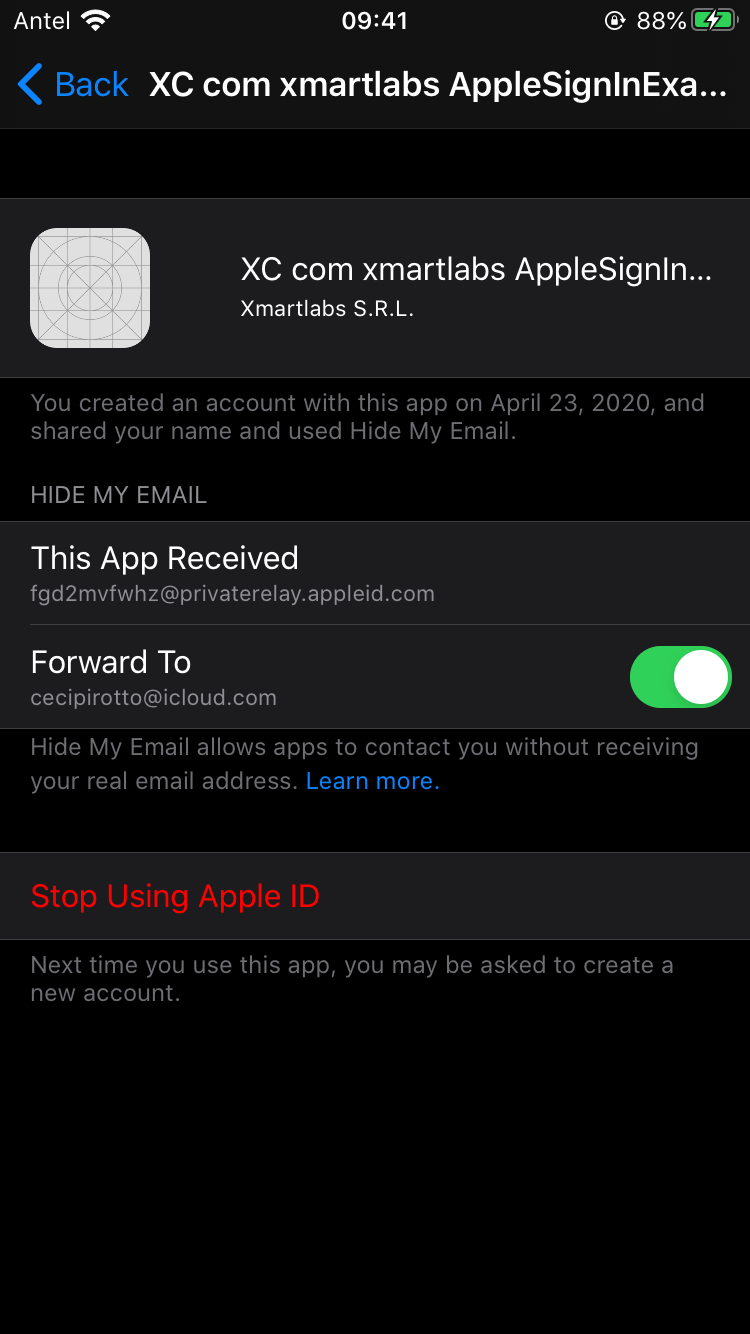
Apple provides a way to know when that happens through an explicit notification so our app can handle it.
We need to register for ASAuthorizationAppleIDProvider.credentialRevokedNotification notification.
NotificationCenter.default.addObserver(self, selector: #selector(appleIDCredentialRevoked(_:)), name: ASAuthorizationAppleIDProvider.credentialRevokedNotification, object: nil)
We can check credential state with getCredentialStateForUserID. Remember that we should have saved the user identifier in our app keychain. Let's implement the function to handle ASAuthorizationAppleIDProvider.credentialRevokedNotification.
@objc func appleIDCredentialRevoked(_ notification: Notification) {
let appleIDProvider = ASAuthorizationAppleIDProvider()
appleIDProvider.getCredentialState(forUserID: userIdentifier) { (credentialState, error) in
switch credentialState {
case .authorized:
// The Apple ID credential is valid. Show Home UI Here
break
case .revoked:
// The Apple ID credential is revoked. Handle unlink
break
case .notFound:
// No credential was found. Show login UI.
break
default:
break
}
}
}
Web and Android solution
Apple provides a JavaScript SDK for Android and Web integration. You can take a look at the Sign in with Apple JS documentation.
Communication between your backend and Apple
Apple provides a REST API to communicate between your app servers and Apple's authentication servers. You can use it to validate the tokens used to verify a user's identity. You can read more about it in the following documentation.
Register your email domains
As we mentioned before, to communicate with app users who taps the hide my email option we must register the app email server domain. You must have already configured Sender Policy Framework (SPF) in order to use it at this point.
In order to configure your email domains enter to Apple Developer Program. Go to Certificates, Identifiers & Profile → More and tap Configure button

Tap + to register your email sources. In Domains and Subdomains section add your domain name, click Next and Register
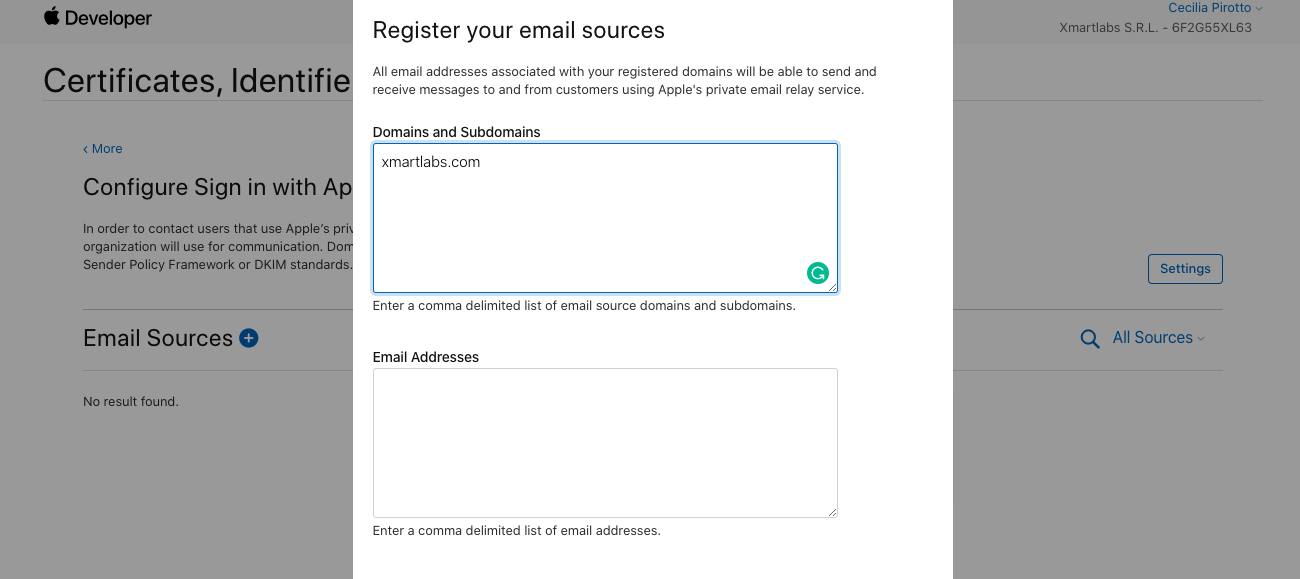
The register will fail if you don't use SPF. If you're using Google to send mails, here you have a configuration guide.
After you get your domain registered, click Download and place the file in the specified location (https://YourDomain/.well-known/apple-developer-domain-association.txt) and click Verify.

Once your domain has passed the verification and is registered to your account, a green checkmark will appear.

Aspects to keep in mind
There are some aspects you should consider if you'll integrate it.
As we mentioned before, developers only receive email and full name once, so if there is a connection issue and you don't save this data locally you won't be able to recover it.
If users choose the hide my email option, it could be difficult to identify the user since the app only holds its apple identifier and its apple private email. So any communication should be done through the app.
Well, I hope now you have a better understanding about Sign in with Apple, its integration cost and if it's suitable for your app!
Are you integrating Sign in with Apple in your app and have learned something not covered in this post? Let me know in the comments. I'd be interested to add it to this blogpost.
Have questions about Sign in with Apple? I'd be happy to answer those in the comments if I can.
